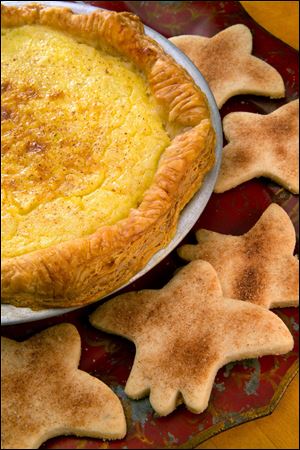
RECIPES
Desserts connect us deliciously with tradition
12/1/2013
Desserts are the sweet stuff of which memories are made, particularly in a holiday season, a time typically so rich with recollections. Serve your guests Marlborough pudding, left, and biscochito (cookies) this season.
Desserts are the sweet stuff of which memories are made, particularly in a holiday season, a time typically so rich with recollections. Salute that spirit with a historic dessert rooted in the North American past. For while tastes, trends, and technology come and go, the country’s sweet tooth has remained ever keen.
Why? Michael Krondl, a New York City food historian and author of Sweet Invention: A History of Dessert, says our continuing hunger for dessert is based on two things: childhood and celebrations. “Sweetness is one of the first tastes we love,” he says, referring to childhood. As for celebrations, “it used to be anything sweet was expensive because of the sugar” so sugar was saved for important things, like wedding cakes, birthday cakes, and Christmas cookies.
“Add those two things up and it sort of represents the culture,” Mr. Krondl says. “We don’t like to change our culture too much. We give lip service to change but we don’t like it too much. So foods stick around.”
Traditional desserts are a particularly delectable way of connecting vividly with that culture. One may not be able to literally step into the shoes of one’s forefathers and foremothers but one can sup pretty much as they did.
But today’s cooks need to remember that desserts — like much of everything else — were different then.
“These recipes were not designed to match anybody’s modern diet plan,” says Frank Clark, supervisor of historic foodways at Colonial Williamsburg, the living history museum in Williamsburg, Va. “There was lots of butter, lots of cream, lots of eggs.”
But that was — and is — part of the charm of historic desserts. Sweets so epitomized hospitality that they were distributed throughout the menu. (“Dessert” as such was defined in the French sense back in Colonial America, as a small palate-cleanser to be enjoyed before leaving the table.)
“Most of the 18th-century upscale entertaining was done with sweets,” says chef Walter Staib of Philadelphia’s City Tavern, host of television’s A Taste of History and author of a new cookbook, A Sweet Taste of History (Lyons, $29.95). “It was a way to show up the Joneses.”
“Today, we don’t go in much for these celebratory everybody-eats-the-cake desserts,” says Mr. Krondl. “They used to make election cakes that served 150 people. The tendency now is that everyone gets their own cupcake.”
Biscochitos
Prep: 25 minutes Chill: 2 to 3 hours
Bake: 10 to 12 minutes per batch
Makes: 40-50 cookies
The story of exploration and settlement in what is now the U.S. was written in languages other than English. These anise cookies were brought to New Mexico by the early Spaniards, who established Santa Fe in 1607. New Mexico declared the biscochito (also spelled bizcochito) the state cookie in 1989. This recipe comes from the New Mexico secretary of state Web site. The yield will vary depending on the size of cutters you use.
6 cups flour
3 teaspoons baking powder
¼ teaspoon salt
2 cups lard
1¾ cups sugar
2 teaspoons anise seeds
2 eggs
¼ cup brandy
1 tablespoon cinnamon
Sift flour in a bowl with baking powder and salt. In separate bowl, cream the lard with 1½ cups sugar and anise seeds until fluffy. Beat in eggs one at a time. Mix in flour mixture and brandy until well blended. Refrigerate, 2-3 hours.
Heat oven to 350 degrees. Turn dough out onto a floured board; pat or roll to ¼ or ½-inch thickness. Cut into shapes. (The fleur-de-lis is traditional.) Place cookies on parchment-paper-lined baking sheets. Mix the remaining ¼ cup sugar and the cinnamon together in a small bowl. Dust the cookies with the cinnamon sugar. Bake until lightly browned, 10-12 minutes.
Nutrition information per cookie (for 50 cookies): 160 calories, 9 g fat, 3 g saturated fat, 15 mg cholesterol, 19 g carbohydrates, 2 g protein, 48 mg sodium, 0 g fiber
Marlborough Pudding
Prep: 30 minutes
Cook: 1 hour
Makes: One 8-inch deep-dish pie, 8 servings
This is one of the most requested recipes at Old Sturbridge Village in Massachusetts. The original recipe from Amelia Simmons’ American Cookery of 1796 is quite terse: “Take 12 spoons of stewed apples, 12 of wine, 12 of sugar, 12 of melted butter, and 12 of beaten eggs, a little cream, spice to your taste; lay in paste No. 3, in a deep dish; bake one hour and a quarter.” This modern adaptation comes from the Old Sturbridge Village Cookbook. Pie dough, homemade or store-bought, can substitute for the puff pastry, if desired.
6 tablespoons butter
Juice of 1 lemon
¾ cup stewed, pureed apples, about 2 apples
¾ cup sherry
½ cup whipping cream
¾ cup white sugar
4 eggs, beaten
1 sheet puff pastry
2 teaspoons grated nutmeg or to taste
Heat oven to 400 degrees. Melt butter in a small saucepan; set aside to cool. Add lemon juice to apples, sherry, cream, and sugar in a bowl; mix well. Add melted butter to mixture, blending well. Add eggs to mixture.
Trim a sheet of puff pastry so that it fits a deep 8-inch pie plate. Season stewed apple mixture with grated nutmeg; spoon mixture into prepared pie plate. Bake, 15 minutes. Reduce heat to 350 degrees; bake until a knife inserted in the center comes out clean, 45 minutes. Cool before serving.
Nutrition information per serving: 277 calories, 18 g fat, 10 g saturated fat, 136 mg cholesterol, 25 g carbohydrates, 4 g protein, 72mg sodium, 0 g fiber